Introduction
In aluminum casting operations, inconsistent temperatures can lead to defects like porous spots or incomplete fills, resulting in scrapped parts, delayed shipments, and reduced efficiency. Proper casting temperatures ensure smooth fluidity and solid components that meet specifications. This guide covers essentials from melting basics to optimization techniques, providing practical steps to improve the process. Targeted heat management can reduce rejection rates by 20%.

1. Melting Point in Casting Temperature of Aluminum
The base melting point for pure aluminum is 660°C (1220°F), but alloys increase this for practical casting.
What Defines the Base Melting Point?
Pure aluminum melts at 660°C, but impurities or alloying elements raise it by 10-50°C depending on composition. Oxidation during heating can alter this threshold, requiring careful monitoring. This influences metal fluidity, preventing clogs in molds.
- Alloy purity levels affect the exact onset of liquidity.
- Environmental humidity introduces moisture that raises effective temps slightly.
- Initial material heating rate ensures even distribution without hot spots.
How to Set Ideal Pouring Ranges?
Target 680-780°C (1256-1436°F) for optimal fluidity without excessive oxidation. Complex molds need the upper end for better flow, while simpler designs work at lower temperatures to save energy. This range minimizes turbulence for smooth filling.
- Enhanced mold filling reduces voids in castings.
- Reduced turbulence cuts gas entrapment risks.
- Better surface finish means less post-processing.
Key Takeaway: Summary Table and Analysis
| Aspect | Pure Aluminum | Common Alloys (e.g., A356) | |
|---|---|---|---|
| Melting Point | 660°C (1220°F) | 615-660°C (1139-1220°F) | |
| Pouring Range | 680-720°C | 680-780°C | |
| Efficiency Impact | Baseline energy use | 10-15% savings with tuned heat |
Alloys adjust baselines for flexibility in energy and quality. Sticking close to ranges prevents 15% more waste from underheating, while excess heat increases costs. Fine-tune for peak efficiency.
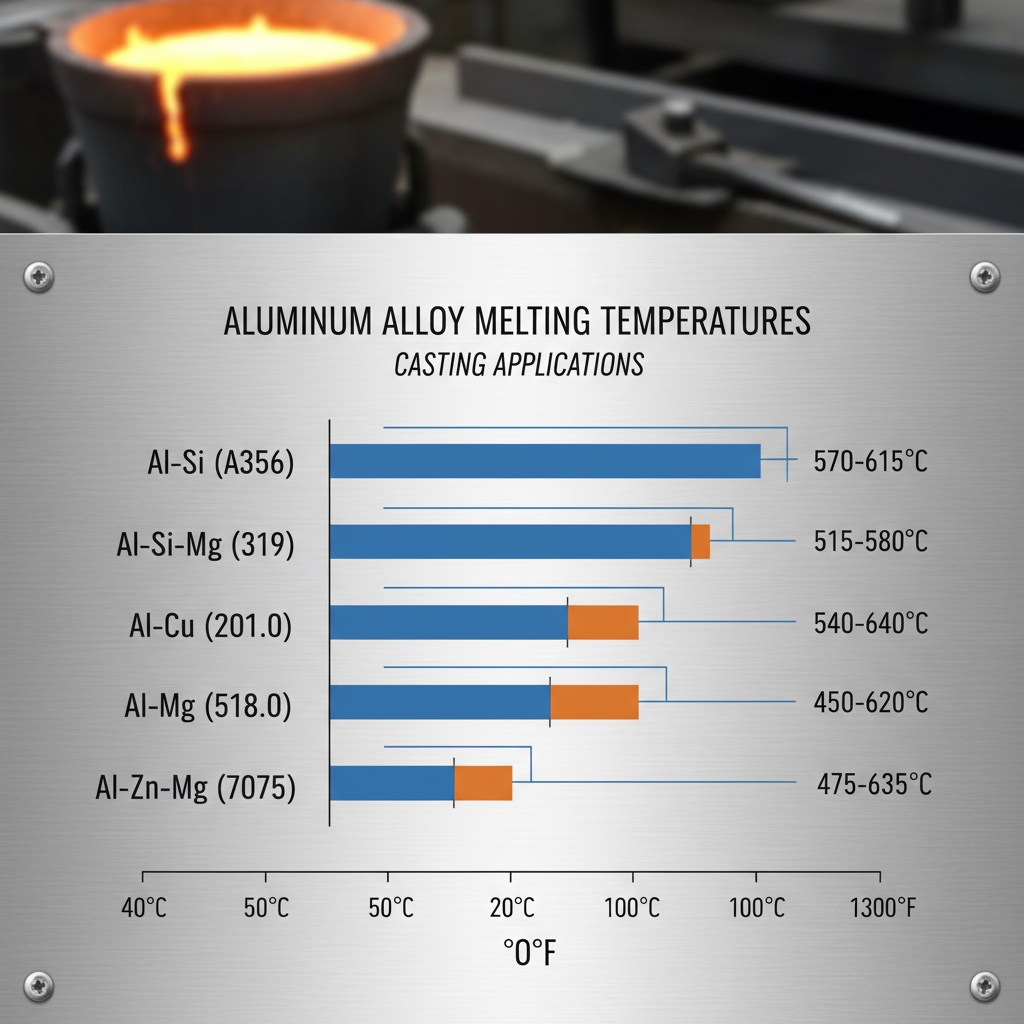
2. Alloys’ Impact on Casting Temperature of Aluminum
Alloys modify the casting temperature by incorporating elements that raise or stabilize the melting point for better performance.
Why Do Alloys Alter Melting Points?
Silicon or copper in alloys elevate the melt by 20-40°C, enhancing strength but requiring hotter pours for flow. Adjustments depend on the blend—pure forms stay low, but industrial mixes need precision to avoid sluggishness. Mismatched temperatures lead to cracks.
- A356 uses Si for superior fluidity at moderated heats.
- 380 incorporates Cu to boost strength in high-stress apps.
- 6061 adds Mg, aiding corrosion resistance without extreme temps.
Which Alloys Best Suit Your Needs?
Choose A356 for automotive parts needing ductility, or 380 for durable housings. Balance cost against properties like tensile yield. Low-Si options suit thin walls. Consider end-use: corrosion-heavy environments favor Mg blends.
- Desired mechanical properties guide the primary pick.
- Cost per unit keeps budgets in check for scaling.
- Environmental compatibility ensures longevity in harsh conditions.
Key Takeaway: Summary Table and Analysis
| Alloy | Key Elements | Temp Range (°C) | Pros/Cons | |
|---|---|---|---|---|
| A356 | Si (7%) | 670-750 | Fluid/ductile; moderate strength | |
| 380 | Cu (3-4%), Si | 680-760 | Strong; prone to porosity if hot | |
| 6061 | Mg (1%), Si | 650-730 | Corrosion-resistant; less fluid |
Ranges show trade-offs: A356 saves energy but sacrifices some toughness, while 380 demands tighter control for 20% stronger outputs. Testing blends optimizes to cut defects by 25%, aligning temperature with project demands.

3. Controlling Casting Temperature of Aluminum
Effective control relies on real-time tools like thermocouples to maintain variances under 10°C.
What Tools Ensure Precise Control?
Thermocouples in furnaces provide instant reads, while pyrometers scan surfaces for hot spots. Integrate with software for alerts to keep melts steady.
- Automated furnace systems adjust heat dynamically.
- PID controllers fine-tune based on feedback loops.
- Infrared sensors detect irregularities non-invasively.
How Does Variance Affect Quality?
A 20°C swing too high causes oxidation, eroding surfaces; too low leads to incomplete fills and weak spots. Porosity spikes 15% from inconsistencies, weakening tensile strength. Close monitoring safeguards integrity.
- Increased porosity traps gases, compromising density.
- Surface defects demand extra finishing work.
- Reduced tensile strength fails load tests.
Key Takeaway: Summary Table and Analysis
| Variance | Effect | Risk Level | Cost Impact | |
|---|---|---|---|---|
| +50°C | Oxidation/dross | High (20%) | +15% scrap | |
| -30°C | Incomplete fill | Medium | +10% rework | |
| ±10°C | Optimal | Low | Baseline |
Tight control slashes oxidation risks by 20%, saving materials. Automation drops overall costs 12%, ensuring consistent quality across batches.

4. Alloy Selection for Casting Temperature of Aluminum
Select alloys like 443.0 for low-temp casting, targeting 680°C to ease flow without excess heat.
Best Alloy for Low-Temp Casting?
Si-rich 443.0 pours smoothly at 680°C, ideal for intricate electronics housings. It minimizes energy while resisting wear.
- 443.0 offers easy flow in thin sections.
- B390 provides wear resistance at similar lows.
How to Balance Temp and Properties?
Test small batches at varied heats to match strength with fluidity. Cooling rates influence final hardness. Consult datasheets, avoiding overheat that brittles edges. Factor mold design; slower cools enhance ductility.
- Test small batches to validate combinations.
- Consult alloy datasheets for spec matches.
- Factor in cooling rates for property tweaks.
Key Takeaway: Summary Table and Analysis
| Alloy | Temp (°C) | Strength (MPa) | Fluidity Rating | |
|---|---|---|---|---|
| 443.0 | 680 | 200 | High | |
| B390 | 690 | 250 | Medium | |
| A356 | 700 | 220 | High |
Low-temp alloys like 443.0 cut energy 10% versus higher ones, with slight strength trade-offs. Hybrid testing boosts yields 18% by aligning temperature to needs.
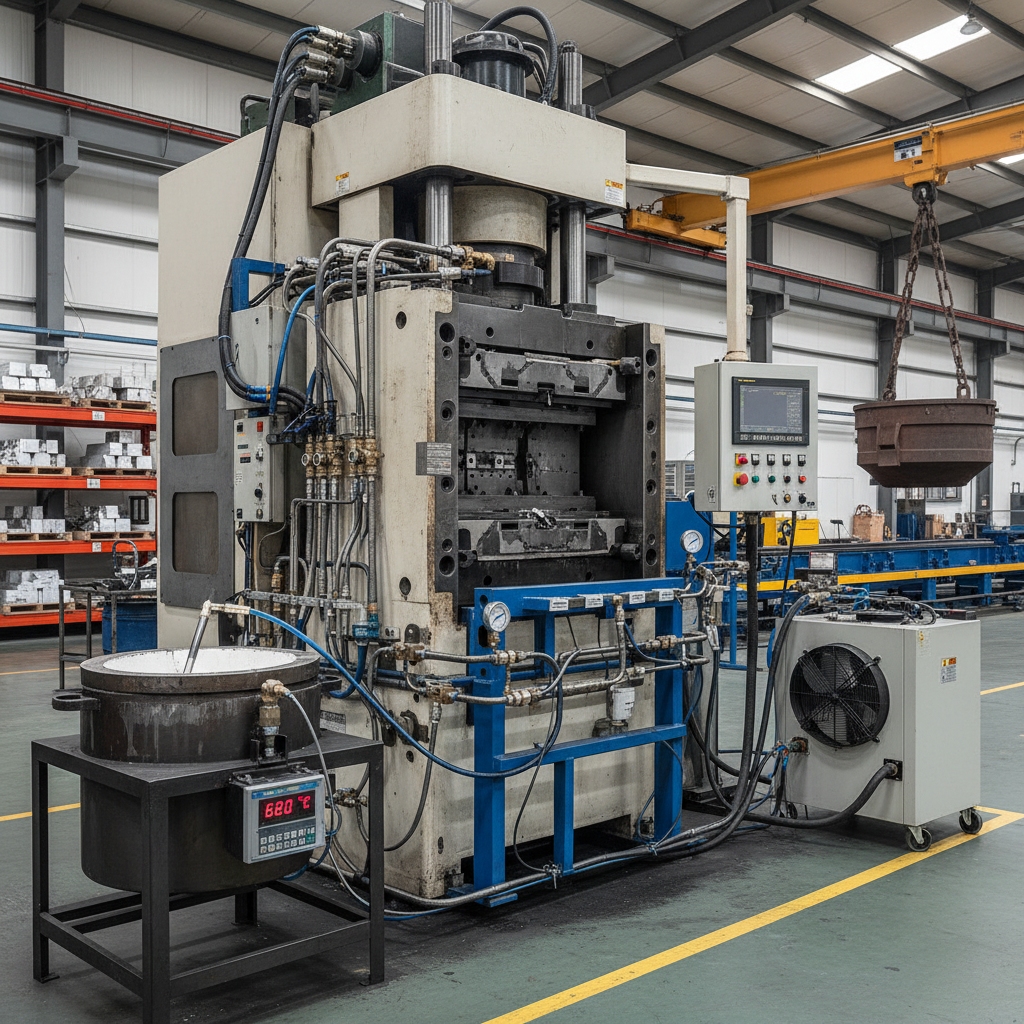
5. Preventing Defects via Casting Temperature of Aluminum
Uniform temperatures around 700°C prevent shrinkage defects by promoting even solidification.
Can Temp Control Avoid Shrinkage?
Holding 700°C ensures metal expands uniformly before cooling, filling risers properly. Superheating gradually matches mold temperatures, avoiding contractions that pull voids.
- Gradual superheating distributes heat evenly.
- Mold preheating syncs expansion rates.
- Alloy modifiers refine grain structure.
What About Gas Porosity Issues?
Degassing at 720°C expels dissolved hydrogen, curbing bubble formation from turbulent pours. Wet charges cause issues; use fluxes for clean melts. Proactive steps keep parts dense.
- Flux addition captures impurities swiftly.
- Vacuum assistance pulls gases out.
- Stirring techniques promote release.
Key Takeaway: Summary Table and Analysis
| Defect | Temp Fix (°C) | Prevention Rate | Reduction Stats | |
|---|---|---|---|---|
| Shrinkage | 700 uniform | 90% | -25% voids | |
| Porosity | 710-730 | 85% | -30% overall |
Targeted temperatures reduce defects up to 30%, enhancing reliability. Integrate these to trim scrap 22%, scaling production without quality lapses.

6. Equipment for Casting Temperature of Aluminum
Induction furnaces provide accurate temperatures with ±5°C precision in melts up to 500kg.
Essential Furnaces for Accurate Temps?
Induction types heat rapidly with electromagnetic fields, ensuring uniform temperatures versus slower crucibles. Capacities suit scale—from prototypes to large runs.
- Rapid heating cycles minimize wait times.
- Temperature uniformity prevents gradients.
- Energy-efficient designs lower bills.
How to Maintain Equipment Reliability?
Schedule weekly calibrations on sensors to catch drifts, alongside refractory checks for cracks. Flush cooling systems monthly to avoid failures. This extends lifespan and prevents stops.
- Daily sensor checks verify accuracy.
- Refractory lining inspections spot wear.
- Cooling system flushes sustain performance.
Key Takeaway: Summary Table and Analysis
| Equipment | Precision (±°C) | Capacity (kg) | ROI Timeline | |
|---|---|---|---|---|
| Induction | 5 | 100-500 | 6-12 months | |
| Crucible | 15 | 50-200 | 12-18 months |
Induction yields faster ROI through 15% less energy waste. Upgrades cut downtime 25%, justifying investment for consistent output.
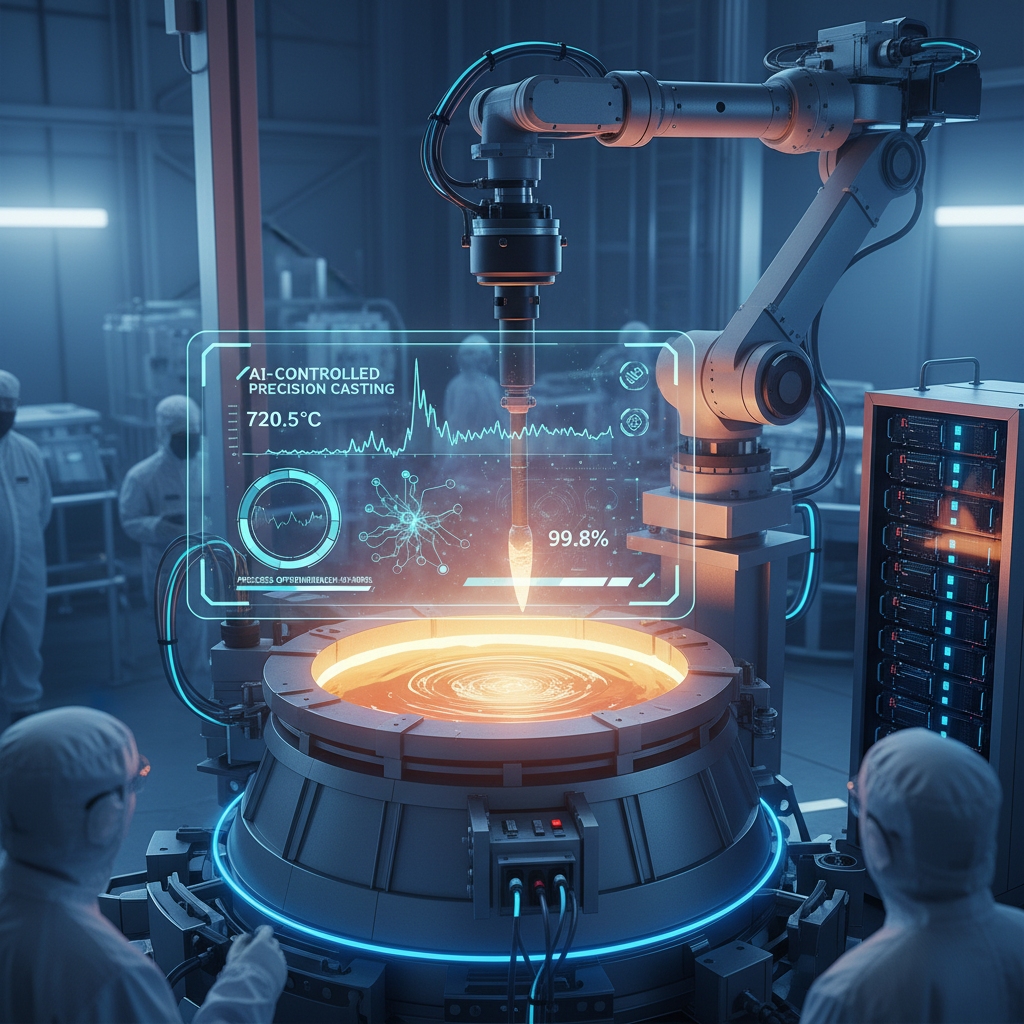
7. Safety Protocols in Casting Temperature of Aluminum
Prioritizing safety at 700°C+ prevents burns and emissions, complying with standards for foundry operations.
Why Prioritize Safety at High Temps?
Molten spills cause severe injuries, while fumes irritate lungs. Controls reduce incidents 40% by zoning hot areas.
- Molten metal splashes demand barriers.
- Thermal stress fatigues workers quickly.
- Toxic emissions require monitoring.
Best PPE for High Temperatures?
Heat-resistant suits and face shields guard against 700°C exposures, paired with training drills. Set alarms at 750°C for evacuations. Full equipping builds confidence.
- Emergency shutdowns halt risks instantly.
- Ventilation systems clear hazardous air.
- Temperature alarm thresholds alert proactively.
Key Takeaway: Summary Table and Analysis
| Protocol | Risk Mitigated | Incident Drop | Compliance Benefit | |
|---|---|---|---|---|
| PPE Suits | Burns/splashes | 50% | Standard alignment | |
| Ventilation | Fumes | 40% | Health standards | |
| Alarms | Overheat | 30% | Audit passes |
Protocols cut incidents 40%, safeguarding the workforce. Integrated systems boost morale and uptime, minimizing liabilities.
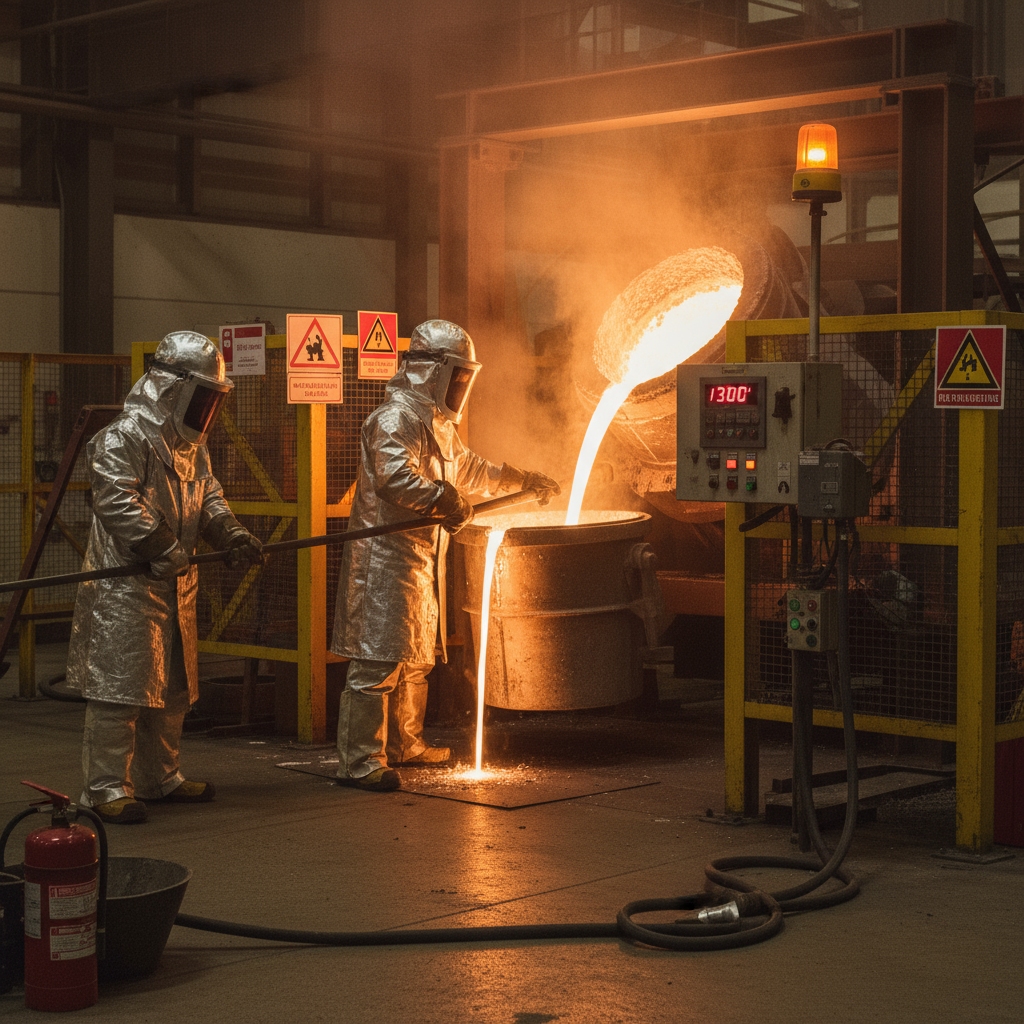
8. Optimizing Casting Temperature of Aluminum
AI-driven monitoring optimizes temperatures, tweaking in real-time for 20% efficiency gains.
Techniques to Fine-Tune for Efficiency?
Feedback loops from sensors adjust furnaces automatically, logging data for patterns. Predictive models forecast drifts based on alloy loads. These tools make efficiency routine.
- Data logging tracks trends.
- Predictive modeling anticipates issues.
- Batch adjustments refine per run.
How Does Optimization Boost Yields?
A 5°C fine-tune slashes scrap in engine parts, achieving 95% yields. Simulations test scenarios pre-pour, minimizing trials.
- Real-time adjustments correct on the fly.
- Alloy-temperature simulations validate choices.
- Post-cast analysis informs next cycles.
Key Takeaway: Summary Table and Analysis
| Metric | Before Opt. | After Opt. | Improvement | |
|---|---|---|---|---|
| Yield % | 85 | 95 | +10% | |
| Scrap Cost | High | Low | -20% | |
| Energy Use | Baseline | Reduced | -15% |
Precise tweaks jump yields, scalable across operations. Deploy these for 18% cost savings and competitive edges.
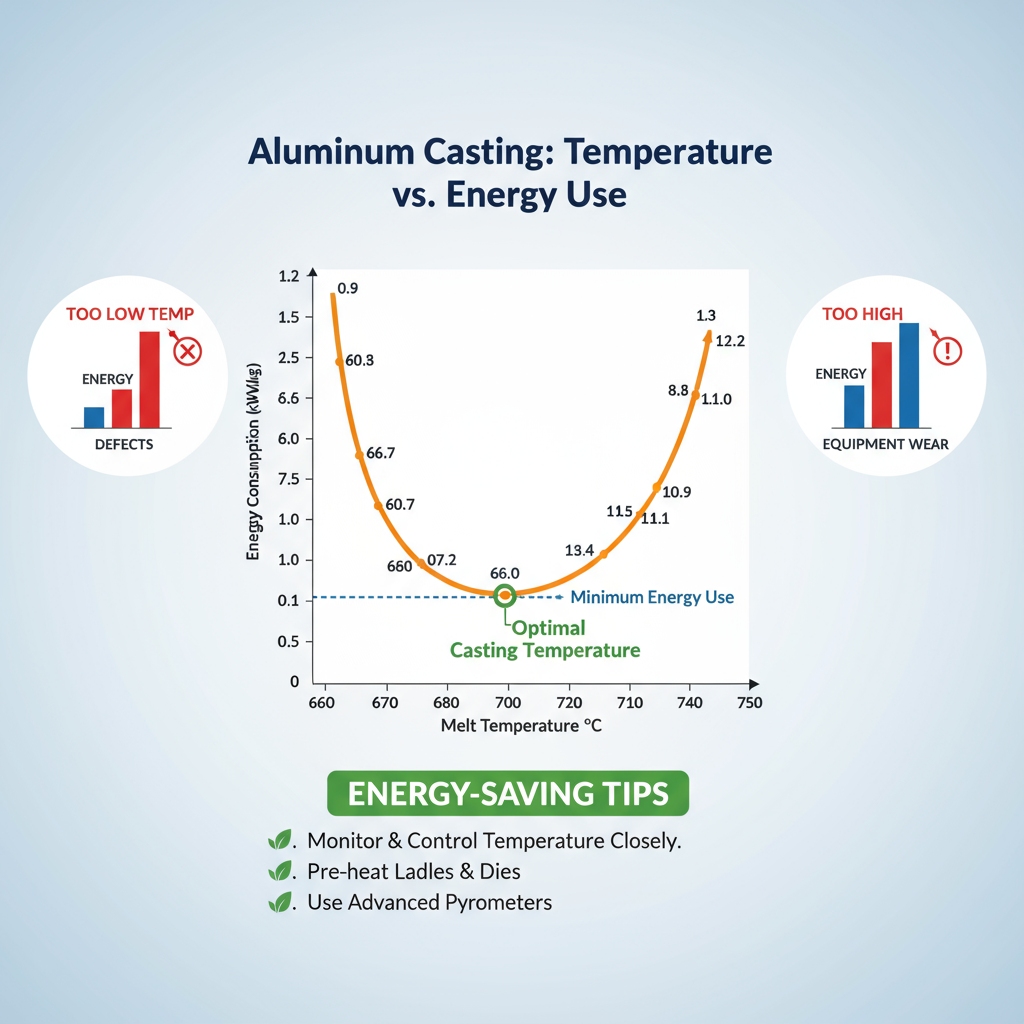
9. Testing Methods for Casting Temperature of Aluminum
Pyrometry tests validate accuracy, ensuring compliance with ±2°C tolerances.
What Tests Validate Temp Accuracy?
In-situ thermocouples measure melts directly, while spectrometry checks composition post-heat. Adhere to ASTM standards for reliability.
- In-situ thermocouples provide live data.
- Post-melt sampling confirms purity.
- Non-destructive scans verify uniformity.
How Often Should You Test?
Per shift in critical runs catches variances; factor volume and alloy changes. Daily for standards, annual audits for certifications. This prevents drifts and maintains trust.
- Daily calibrations keep tools sharp.
- Pre-production checks set baselines.
- Annual audits ensure long-term accuracy.
Key Takeaway: Summary Table and Analysis
| Test Type | Accuracy (±°C) | Frequency | Benefit | |
|---|---|---|---|---|
| Pyrometry | 2 | Per run | Quick validation | |
| Spectrometry | 5 | Post-melt | Composition check | |
| Thermocouples | 3 | Continuous | Real-time control |
Pyrometry’s speed aids compliance. Routine testing drops defects 25%, fortifying quality assurance.
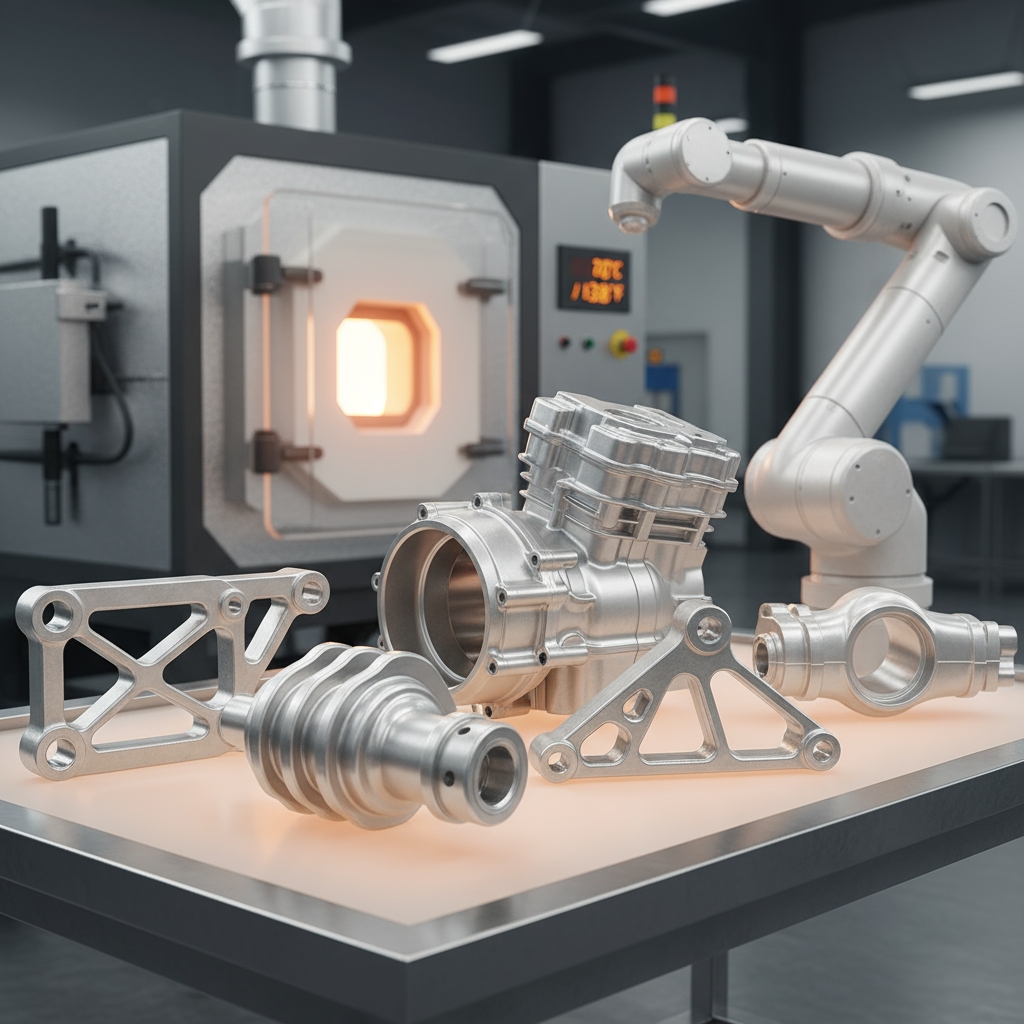
10. Applications of Casting Temperature of Aluminum
Temperature control excels in automotive castings at 700-750°C, enabling lightweight, durable components like engine blocks.
Where Does Temp Control Shine in Auto?
740°C pours fill complex blocks seamlessly, reducing weight by 30% over steel. Benefits include better fuel efficiency for EVs.
- Lightweight chassis improve handling.
- Heat exchangers manage thermal loads.
- Transmission housings endure stresses.
How About Aerospace Demands?
710°C precision meets tight tolerances for turbine parts, ensuring fatigue resistance. Variances under 5°C prevent cracks in flight-critical applications.
- Turbine components handle extremes.
- Structural fittings support airframes.
- Fuel systems resist corrosion.
Key Takeaway: Summary Table and Analysis
| Industry | Optimal Temp (°C) | Key App | Market Growth | |
|---|---|---|---|---|
| Auto | 700-750 | Engine blocks | 12% CAGR | |
| Aerospace | 710-740 | Turbines | 15% CAGR | |
| General | 680-780 | Housings | 10% CAGR |
Precision fuels expansion in growth sectors. Adopters see 15% market uplift, leveraging control for broader applications.
Conclusion
Unchecked temperatures cause melting mishaps, defects, and safety issues in aluminum casting. Mastering ranges from 680-780°C, alloy tweaks, and tool integrations delivers flawless parts and streamlines operations. These insights enable transformation of pitfalls into achievements.
FAQ
Q1: Is 700°C always ideal for aluminum casting? No, it depends on alloy and mold—higher for complex designs ensures flow but risks oxidation; lower suits simple parts to save energy. Balancing fluidity with defect prevention optimizes quality.
Q2: How do alloys change required temperatures? They raise melting points slightly—e.g., copper adds 20-30°C for strength. Elements like Si improve castability at moderated temperatures, tailoring to application needs.
Q3: What if temperature exceeds 780°C? Avoid it—leads to excessive wear and impurities. Overheating causes dross and weakens parts, increasing costs; stick to 680-780°C for safe production.
Q4: Can you automate temperature control? Yes, with sensors and software—boosts consistency. Automation minimizes error, reduces variability by 50%, and enhances yield in high-volume runs.
Q5: Why test casting temperatures regularly? Essential for compliance and quality—catches drifts early. Variations cause defects; routine checks ensure standards adherence, protecting reputation and costs.



